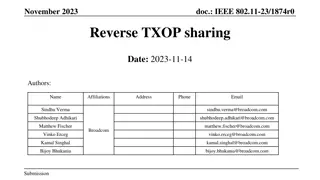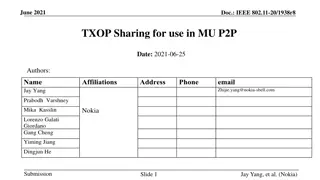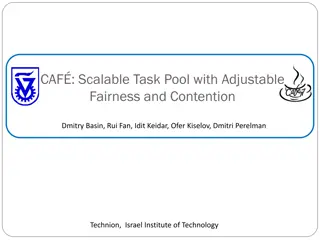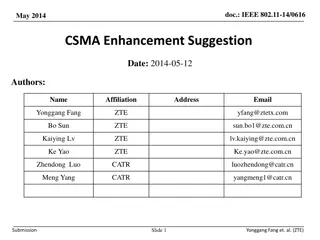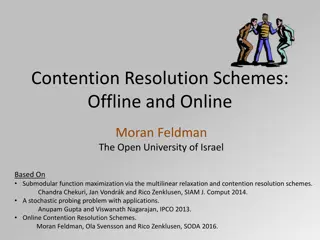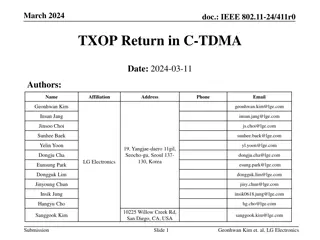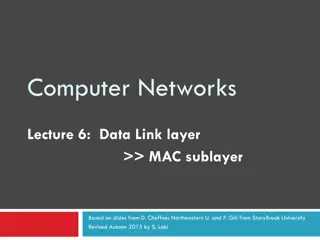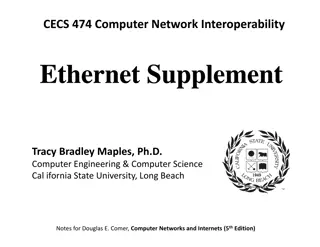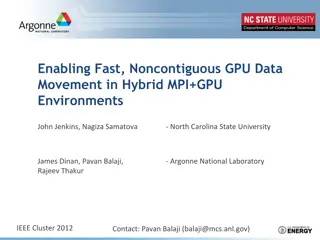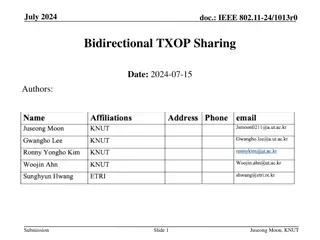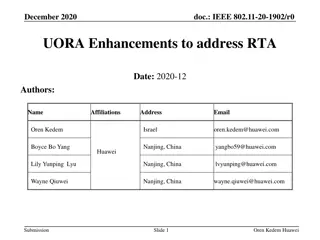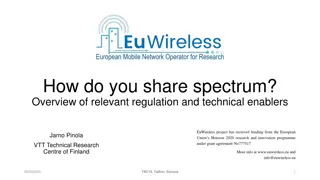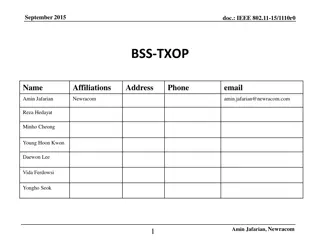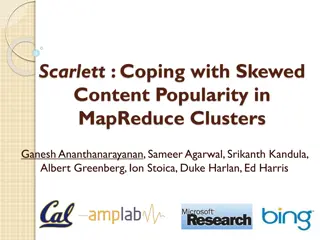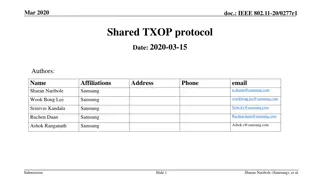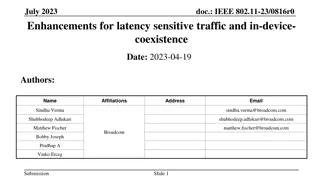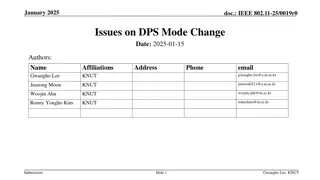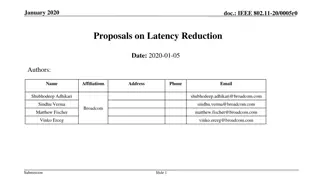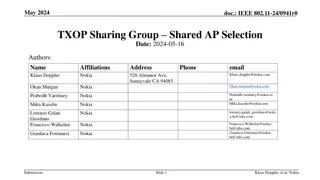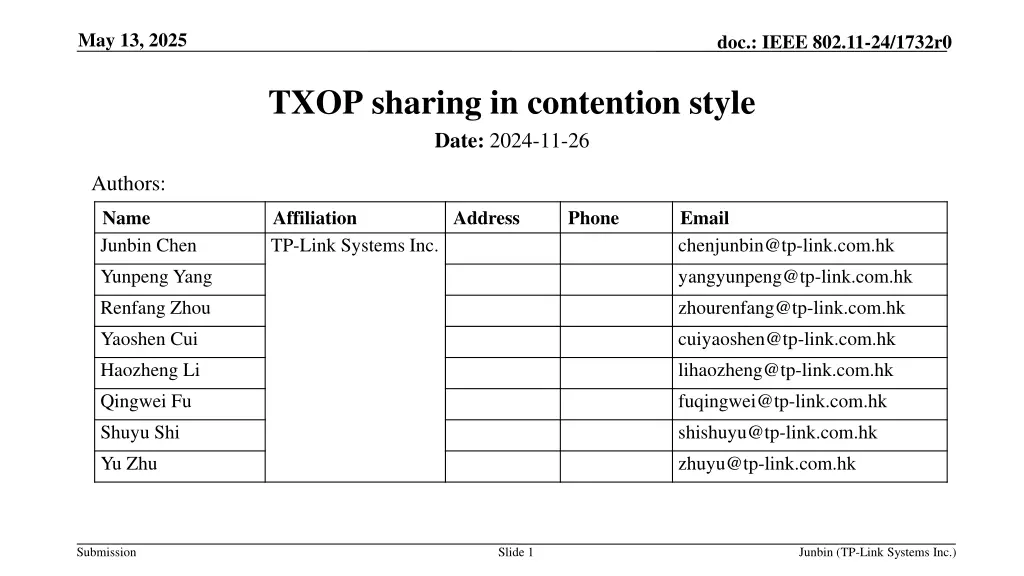
Enhancing TXOP Sharing in IEEE 802.11 Networks
Delve into the proposal of TXS with puncturing mode to address non-periodic low latency traffic challenges in IEEE 802.11 networks. Explore the Coordinated TDMA procedure and the issues surrounding LL traffic arrival, sharing AP delays, information collection complexities, and proposed solutions. Discover how preemption can optimize LL traffic indication in contention style networks for improved performance.
Download Presentation

Please find below an Image/Link to download the presentation.
The content on the website is provided AS IS for your information and personal use only. It may not be sold, licensed, or shared on other websites without obtaining consent from the author. If you encounter any issues during the download, it is possible that the publisher has removed the file from their server.
You are allowed to download the files provided on this website for personal or commercial use, subject to the condition that they are used lawfully. All files are the property of their respective owners.
The content on the website is provided AS IS for your information and personal use only. It may not be sold, licensed, or shared on other websites without obtaining consent from the author.
E N D
Presentation Transcript
May 13, 2025 doc.: IEEE 802.11-24/1732r0 TXOP sharing in contention style Date: 2024-11-26 Authors: Name Junbin Chen Yunpeng Yang Renfang Zhou Yaoshen Cui Haozheng Li Qingwei Fu Shuyu Shi Yu Zhu Affiliation TP-Link Systems Inc. Address Phone Email chenjunbin@tp-link.com.hk yangyunpeng@tp-link.com.hk zhourenfang@tp-link.com.hk cuiyaoshen@tp-link.com.hk lihaozheng@tp-link.com.hk fuqingwei@tp-link.com.hk shishuyu@tp-link.com.hk zhuyu@tp-link.com.hk Submission Slide 1 Junbin (TP-Link Systems Inc.)
May 13, 2025 doc.: IEEE 802.11-24/1732r0 Abstract UHR PAR [1] has determined to improve the tail of the latency distribution, and in 11bn SFD [2] agrees that: TGbn shall define a Coordinated TDMA (Co-TDMA) procedure for an AP to share its time resources of an obtained TXOP with a set of APs. Set of APs is TBD. The set can consist of one AP. There have been several contributions on C-TDMA, and a popular idea is to extend the TXOP Sharing (TXS) procedure in 11be [3-9]. In this presentation, we d like to discuss about the TXS method for handling the non-periodic low latency (NPLL) traffic in the absence of buffer status report. The sharing AP needs the information about the buffer status of shared AP to schedule the TXS. The arrival of non-periodic LL traffic is hard to be predicted in advance. Submission Slide 2 Junbin (TP-Link Systems Inc.)
May 13, 2025 doc.: IEEE 802.11-24/1732r0 The C-TDMA in TGbn There still remains several issues in the C-TDMA of previous contributions: 1. If the LL traffic of sharing AP arrives during the sharing procedure, it will waits until TXOP return [11-12]. MU-RTS TXS LL traffic arrives and suffers delay Data transmission Sharing AP Txop return CTS Data transmission Shared AP 2. The sharing AP needs to collect the information of the pending LL traffic of multiple shared APs and determines which shared AP to be the TXS responder based on such information. However, the information collection can be quite difficult for the non-periodic low latency (NPLL) traffic. MU-RTS TXS MU-RTS TXS BSRP Sharing AP1 Data Txop return LL traffic arrives CTS BSR Shared AP2 transmission Data Txop return LL traffic arrives CTS BSR Shared AP3 transmission NPLL traffic arrives and suffers delay BSR Shared AP4 Submission Slide 3 Junbin (TP-Link Systems Inc.)
May 13, 2025 doc.: IEEE 802.11-24/1732r0 Proposal 1: TXS with puncturing mode We propose to define a mode that: The sharing AP can share a subset of its bandwidth to the shared AP(s), and operate with the remaining bandwidth in the puncturing mode during the allocated duration. In such mode, the sharing AP is still available to deliver any possible LL traffic arrived during the allocated TXS duration in puncturing mode. Further, the sharing AP may announce multiple bandwidth units (BWUs) for multiple shared APs. LL traffic arrives and can be delivered Data transmission in puncturing mode MU-RTS TXS Sharing AP1 BWU1 shared to AP2 BWU2 shared to AP3 Data transmission Shared AP2 CTS Data transmission Shared AP3 CTS Data transmission Submission Slide 4 Junbin (TP-Link Systems Inc.)
May 13, 2025 doc.: IEEE 802.11-24/1732r0 Proposal 2: use preemption for LL traffic indication Preemption has been discussed in many previous contributions [10-13], where a preemptor is allowed to send a preemption request indication (PRI) signal to the TXOP holder. The PRI signal shall be a simple signal that is easy to be detected rather than a complete PPDU [14]. The TXOP holder s transmission then is suspended and the preemptor takes the TXOP over. However, this is kind of unfair to the TXOP holder, and does not fit for multiple preemptors. A good alternative is: The preemptor use the PRI signal to indicate the presence of LL traffic. The preemptee then determines to initiate a TXOP sharing to the preemptor or not. The preemptor shall transmit its LL traffic in the shared TXOP (if present). xIFS LL traffic arrived OBSS AP PRI TXOP sharing xIFS xIFS AP1 DL+PR enabled DL+PR enabled DL+PR enabled (TXOP holder) STA1 Submission Slide 5 Junbin (TP-Link Systems Inc.)
May 13, 2025 doc.: IEEE 802.11-24/1732r0 Proposal 3: allow contention in TXS duration (1/2) Considering the fact that the NPLL traffic arrives randomly, we suggest to allow some shared APs to contend some RA-BWUs for their NPLL traffic The contention can be EDCA-based or UORA-based, TBD. The number of shared APs allowed to participated in the contention can be limited by conditions (e.g., the delay bound limit) announced by sharing AP. The same RA-BWU can be utilized by more than one shared APs if there is more allocated TXS duration left. Data transmission in puncturing mode MU-RTS TXS Sharing AP1 BWU1 for AP2 Data transmission RA-BWU2 Shared AP2 CTS Data transmission on BWU1 Shared AP3 Win RA-BWU2 Shared AP4 Win RA-BWU2 Submission Slide 6 Junbin (TP-Link Systems Inc.)
May 13, 2025 doc.: IEEE 802.11-24/1732r0 Proposal 3: allow contention in TXS duration (2/2) Considering the fact that the NPLL traffic arrives randomly, we suggest to allow some shared APs to contend some RA-BWUs for their NPLL traffic Also, the sharing AP may assign a contention-free period in RA-BWU for a specific shared AP, during which the specific shared AP can use the RA-BWU without contention. Data transmission in puncturing mode MU-RTS TXS Sharing AP1 BWU1 for AP2 Data transmission RA-BWU2, (AP3 contention-free) Shared AP2 CTS Data transmission on BWU1 Shared AP3 RA-BWU2 Contention-free Shared AP4 Win RA-BWU2 Submission Slide 7 Junbin (TP-Link Systems Inc.)
May 13, 2025 doc.: IEEE 802.11-24/1732r0 The priority of shared APs 1. The shared APs which are assigned a specific BWU with a CFP is of the highest priority during the contention. 2. The sharing AP can announce some constraints (e.g. the delay bound requirement) in the MRTT frame. For example, only the shared APs whose delay bound of the pending LL data is lower than the announced requirement can participate in the contention. An exemplary of the MRTT can be defined as follow. MAC Header Common info User info list Padding FCS BWU index BWU size Allocation duration Contention-free period Delay requirement APID 3. The contention for RA-BWU can be performed in a similar way as EDCA, or in the UORA contention style. In EDCA style, the shared APs shall initiate a TXS back-off counter based on the delay bound of pending LL data. In UORA style, the shared AP shall invoke the OBO contention procedure and transmit a RTS to protect its following transmission. Submission Slide 8 Junbin (TP-Link Systems Inc.)
May 13, 2025 doc.: IEEE 802.11-24/1732r0 Advantages of the proposal Support for non-periodic LL traffic The PRI signal indicates the non-periodic LL traffic arrivals. The shared APs with LL traffic can contend for the RA-BWUs, without sending BSR. Support for multiple shared APs The sharing AP can reserve multiple BWUs for multiple shared APs. One reserved BWU can be reused by multiple shared APs if they are capable of spatial reuse. Compatibility with the previous contributions in TGbn The sharing AP can also assign specific BWUs to some specific shared APs based on prior knowledge. The sharing AP can indicate a contention-free period in MRTT, during which the BWU is assigned to a specific AP. The other APs can contend for that BWU after the contention-free period, if it is less than the Announced TXS duration. Submission Slide 9 Junbin (TP-Link Systems Inc.)
May 13, 2025 doc.: IEEE 802.11-24/1732r0 Summary The arrival of non-periodic (NP) low-latency (LL) traffic is unknown to the sharing AP. The sharing AP has to query the buffer status of multiple shared APs over and over again. The NP-LL traffic of sharing AP may also arrive during the TXS procedure and suffer significant delay. In this presentation, we proposed a special TXS mode for NPLL traffic: - The sharing AP has no need to query the information such as buffer status from shared APs. - The sharing AP can reserve some sub-channels which are announced for TXOP sharing. - The sharing AP continues its data transmission on the remaining parts of its bandwidth. - The reserved sub-channels are assigned to or contended by multiple shared APs with LL traffic. - The priority of multiple shared APs can be distinguished by the contention procedure. Submission Slide 10 Junbin (TP-Link Systems Inc.)
May 13, 2025 doc.: IEEE 802.11-24/1732r0 References [1] 23/0480-uhr UHR Proposed PAR [2] 24/0209-bn Specification Framework for TGbn [3] 24/0512-bn Considerations for Coordinated TDMA, Rubayet Shafin (Samsung Electronics) [4] 24/0411-bn TXOP Return in C-TDMA, Geonhwan Kim (LG Electronics) [5] 24/1895-bn C-TDMA frame sequence, Abhishek Patil (Qualcomm) [6] 23/0261-uhr TDMA for wifi-8, Dibakar Das (Intel) [7] 23/0041-uhr Considerations on Coordinated TDMA, Yanjun Sun (Qualcomm) [8] 23/0249-uhr extended TXOP sharing, Liwen Chu (NXP) [9] 23/1085-uhr Thoughts on Coordinated TDMA, Geonhwan Kim (LG Electronics) [10] 24/0636-bn Multi-AP Preemption for Low-Latency Traffic, Si-Chan Noh (Newracom) [11] 24/0866-bn Preemption for C-TDMA, Jiayi Zhang (Ofinno) [12] 24/0852-bn Timely transmission of Low latency traffic with reduced preemption occurance, Jerome Gu (Clourney Semiconductor) [13] 24/1257-bn Preemption Procedure and Indication- Follow Up, Yunbo Li (Huawei) [14] 24/0413-bn Signal for preemption request, Xiangxin Gu (Spreadtrum) [15] 23/0768-uhr Discussion on C-OFDMA operation, Jinyoung Chun (LG Electronics) Submission Slide 11 Junbin (TP-Link Systems Inc.)

